
News |
- Happy Holidays from Manitoba Wildlands
- Bipole III Comments Deadline Announced
- Caribou Action Plan Open for Comment
- Time for a Tobin Tax?
- Durban Ends With Agreement After All
- Canada Withdraws From Kyoto: Faces International Criticism
- Keeyask Environmental Reviews Begin
- BC Is Fracking Up, Says Study
- Durban Negotiations Go Overtime, Treaty Still Unlikely
- Chomiak Says Kyoto Dead in Manitoba
- Delta Marsh Research Station Closed Permanently
- Bipole III Licensing Hearings Announced
| Happy Holidays from Manitoba Wildlands | 23 December 11 |

|
|
 Print version Print version |
Top |
| Bipole III Comments Deadline Announced | 23 December 11 |
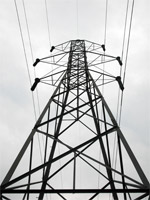 Comments on Manitoba Hydro's Bipole III Environmental Impact Statement (EIS) are due by March 16, 2012. Following the public comments period, an updated EIS maybe filed. The Clean Environment Commission will then hold hearings during 2012.
Comments on Manitoba Hydro's Bipole III Environmental Impact Statement (EIS) are due by March 16, 2012. Following the public comments period, an updated EIS maybe filed. The Clean Environment Commission will then hold hearings during 2012.The timing of the review period raised some concerns. "It is inappropriate for a review period to fall squarely in the holiday season when many government offices are closed. Many First Nation offices will be closed for three weeks over the holidays. The 90 day review period should be extended accordingly," said Manitoba Wildlands Director Gaile Whelan Enns. The EIS documents are available in paper copy at Manitoba Public Registry locations, and online through Manitoba Hydro's website. It remains unclear if a federal review under the Canadian Environmental Assessment Act (CEAA) will be required. The June 2011 final Scoping Document for Bipole III states: "It is anticipated that Manitoba Conservation will coordinate a cooperative environmental assessment process ... under The Environment Act and the Canadian Environmental Assessment Act." (pg. 3) Yet the December 2011 EIS for Bipole III now states: "In the case of Bipole III, Manitoba Hydro is of the opinion that an environmental assessment will not be required pursuant to federal legislation." (pg. 1-11) Responsible federal authorities are presently reviewing the EIS. View Manitoba Conservation, Bipole III Transmission Project: Online Public Registry file #5433View Manitoba Conservation, Public Advertisement on the Bipole III Transmission Project (PDF) View Manitoba Hydro Bipole III Environmental Impact Statement (EIS) View Manitoba Conservation, Scoping Document for Bipole III (PDF) View December 7, 2011 Manitoba Wildlands news item View Energy Manitoba, Bipole III page Source:
Government of Manitoba, Manitoba Hydro
|
|
 Print version Print version |
Top |
| Caribou Action Plan Open for Comment | 23 December 11 |
 Feedback and input on draft "Action Plans for Boreal Woodland Caribou Ranges in Manitoba" intended to protect boreal woodland caribou populations in the eastern side of Manitoba can now be provided.
Feedback and input on draft "Action Plans for Boreal Woodland Caribou Ranges in Manitoba" intended to protect boreal woodland caribou populations in the eastern side of Manitoba can now be provided."Boreal woodland caribou are a threatened species, and the Owl-Flintstone and Atikaki-Berens caribou populations are particularly vulnerable," said Chomiak. "We’ve worked with the Eastern Manitoba Woodland Caribou Advisory Committee to develop plans to protect these populations and are now seeking input from the public to make sure these plans are as complete as possible." The public will have 90 days to comment on the proposal. It is unclear when this 90 period starts or ends, but the announcement was made December 21, 2011. Following the public comment period, additional discussion will be initiated with First Nations and other stakeholders. The final action plans will be released by the summer of 2012. "As Manitoba has issued new woodland caribou plans the number of herds on the east side has reduced. It maybe time for an independent assessment of our woodland caribou," said Manitoba Wildlands Director Gaile Whelan Enns. A Canada wide woodland caribou strategy review under the federal Species At Risk Act (SARA) is also underway with public comments due by February 22, 2012. View December 2011 Draft: Action Plans for Boreal Woodland Caribou Ranges in Manitoba (PDF)View December 21, 2011 Government of Manitoba press release View December 21, 2011 Winnipeg Free Press article View 2006 Government of Manitoba Conservation and Recovery Strategy for Boreal Woodland Caribou (PDF) View 2000 Government of Manitoba, Woodland Caribou (Rangifer Tarandus Caribou) Conservation Strategy For Manitoba View August 25, 2010 Manitoba Wildlands news item View more on Manitoba Wildlands, Caribou Strategies page Source:
Government of Manitoba
|
|
 Print version Print version |
Top |
| Time for a Tobin Tax? | 23 December 11 |
 Support for a financial transaction tax (FTT) that could raise several hundred billion in revenue to fight poverty and climate change is gaining momentum.
Support for a financial transaction tax (FTT) that could raise several hundred billion in revenue to fight poverty and climate change is gaining momentum.A Robin Hood Tax or Tobin Tax – named after Nobel Laureate economist James Tobin who proposed the idea in 1971 – is a is a tiny tax (0.03% to 0.05%) that would be levied on all financial market transactions. It would be applied to financial transactions traded through stock exchanges, futures exchanges or any facility established for the purpose of trading ("exchange trading"). Influential champions, including leaders of France and Germany, billionaire philanthropists Bill Gates and George Soros, former Vice President Al Gore, the consumer activist Ralph Nader, Pope Benedict XVI and the archbishop of Canterbury all support the idea. More than 1000 economists signed onto a letter in April 2011, urging G20 member nations to adopt a Tobin Tax. Supporters tout the idea as a way to fund the unfulfilled Millennium Development Goals and, as of yet, empty Green Climate Fund, while also hampering needless financial speculation that destabilizes economies. On March 23rd, 1999, the Canadian Parliament demonstrated world leadership when it passed motion M-239 urging Canada to "enact a tax on financial transactions in concert with the international community." The Canadian motion sparked a global movement in support of controls on speculative capital. The Brazilian Parliament held hearings on the Tobin tax in August, 1999. The European Parliament debated the Tobin tax in January, 2000. The Canadian government has acted only minimally on both letter and spirit of the motion passed in 1999. Stephen Harper, and the current Canadian government is one of the leading opponents of a Tobin Tax, despite support from other politicians like French President, Nicolas Sarkozy. View December 16, 2011 Huffington Post articleView December 12, 2011 New York Times article View December 8, 2011 Economic Times of India article View November 1, 2011 Archbishop of Cantebury blog View October 25, 2011 National Union of Public and General Employees View October 24, 2011 Pontifical Council for Justice and Peace report (PDF) View April 2010 Halifax Initiative Policy Brief View March 20, 2000 Canadian Conference of Catholic Bishops, Open Letter to Members of Parliament regarding the Tobin Tax View June 1996 Canadian Parliamentary Publication View Oxfam Climate Financing in Durban page View Robin Hood Tax organization page Source:
Huffington Post, Oxfam, Arcbishop of Cantebury, Canadian Conference of Catholic Bishops
|
|
 Print version Print version |
Top |
| Durban Ends With Agreement After All | 16 December 11 |
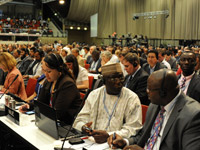 Climate negotiations in Durban, South Africa went almost 24 hours overtime and surprisingly ended with several important decisions centred on adaption, green climate fund, technology and strategies to support developing countries, being adopted.
Climate negotiations in Durban, South Africa went almost 24 hours overtime and surprisingly ended with several important decisions centred on adaption, green climate fund, technology and strategies to support developing countries, being adopted.The conference included the seventeenth session of the Conference of the Parties (COP 17) to the UN Framework Convention on Climate Change (UNFCCC) and the seventh meeting of the Conference of the Parties serving as the Meeting of Parties to the Kyoto Protocol (CMP 7). Governments decided in Durban to adopt a new universal legal agreement on climate change that will apply to all countries no later than 2015. A new group called the Ad Hoc Working Group on the Durban Platform for Enhanced Action is tasked with implementing this goal. Although the details remain to be worked out, 38 industrialized nations, largely from Europe, also agreed to further targets and reporting under a second Kyoto Protocol commitment period beginning on January 1, 2013 and ending in 2017. "I salute the countries who made this agreement. They have all laid aside some cherished objectives of their own to meet a common purpose - a long-term solution to climate change," said Christiana Figueres, Executive Secretary of UNFCCC. A significantly advanced framework for the reporting of emission reductions for both developed and developing countries was also agreed, taking into consideration the common but differentiated responsibilities. The next UNFCC Conference of the Parties (COP18) takes place 26 November to 7 December 2012 in Qatar. View Manitoba Wildlands COP17 pageView December 13, 2011 International Institute for Sustainable Development (IISD) Earth Negotiations Bulletin View December 12, 2011 Al Jazeera article View December 11, 2011 AllAfrica.com article View December 11, 2011 Climate Action Network press release View December 11, 2011 Pembina Institute press release View December 11, 2011 Guardian article View United Nations Framework Convention on Climate Change (UNFCC) reports View United Nations Framework Convention on Climate Change (UNFCC) Kyoto Protocol backgrounder View more information on Manitoba Wildlands Source:
AllAfrica.com, IISD, Pembina Institute, Guardina
|
|
 Print version Print version |
Top |
| Canada Withdraws From Kyoto: Faces International Criticism | 16 December 11 |
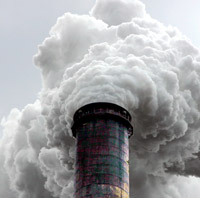 A day after returning home from United Nations Framework on Convention on Climate Change (UNFCCC) negotiations in Durban, South Africa, Canadian Environment Minister Peter Kent announced: "We are invoking Canada's legal right to formally withdraw from Kyoto." Under the terms of the Kyoto Protocol countries must give one-year's notice to withdraw.
A day after returning home from United Nations Framework on Convention on Climate Change (UNFCCC) negotiations in Durban, South Africa, Canadian Environment Minister Peter Kent announced: "We are invoking Canada's legal right to formally withdraw from Kyoto." Under the terms of the Kyoto Protocol countries must give one-year's notice to withdraw.The Kyoto Protocol was signed in 1997 in Kyoto Japan and came into force in 2005. Canada adopted Kyoto by a vote of the House of Commons in 2002. It is a sub-agreement, under UNFCCC, which was signed in 1992 at the Earth Summit and came into force in 1994. Canada remains a party to, and still has international legal obligation to the UNFCCC. "I regret that Canada has announced it will withdraw and am surprised over its timing. Whether or not Canada is a Party to the Kyoto Protocol, it has a legal obligation under the [UNFCCC] Convention to reduce its emissions, and a moral obligation to itself and future generations to lead in the global effort," said UNFCCC Chief Christiana Figueres. "It's a national disgrace. Prime Minister [Stephen] Harper just spat in the faces of people around the world for whom climate change is increasingly a life-and-death issue," said Graham Saul of Climate Action Network Canada. German Environment Minister Norbert Röttgen called Canada's announcement "unnecessary and in that respect very unpleasant." A spokesperson for France's foreign ministry said the decision is "bad news for the fight against climate change, An official in India said Canada's decision could jeopardise any gains made at the Durban meeting. Even Japan, who like Canada and Russia was unwilling to sign up for a second commitment period under the Kyoto Protocol at climate negotiations, urged Canada to stay with the Kyoto framework. View December 16, 2011 CTV News articleView December 14, 2011 Spiegel International article View December 13, 2011 CBC article Watch December 13, 2011 CBC interview with Elizabeth May View December 13, 2011 United Nations Framework Convention on Climate Change release View December 12, 2011 Sierra Club of Canada press release View Kyoto Protocol Implementation Act View more information on Manitoba Wildlands Source:
CBC, CTV, United Nations
|
|
 Print version Print version |
Top |
| Keeyask Environmental Reviews Begin | 16 December 11 |
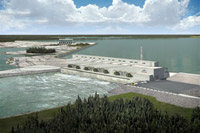 The federal and provincial environmental effects assessments and licensing process for the next Manitoba next dam have begun. The Keeyask Generation Project, a 695-megawatt dam, would be located on the Nelson River near Gillam, Manitoba.
The federal and provincial environmental effects assessments and licensing process for the next Manitoba next dam have begun. The Keeyask Generation Project, a 695-megawatt dam, would be located on the Nelson River near Gillam, Manitoba.The proponent, Keeyask Hydro Power Limited Partnership, (a partnership between Manitoba Hydro and four Manitoba First Nations), submitted a project description for the Keeyask Generating Station to Canadian Environmental Assessment Agency (The Agency) for review under the Canadian Environmental Assessment Act (CEAA) August 31, 2011. The Agency determined that a comprehensive study, which commenced November 29, 2011, was required and made available funding under its Participant Funding Program available. A Manitoba Environment Act license would also be required. The proponents filed an Environment Act Proposal Form (EAPF) and a "Scoping Document for the Environmental Assessment of the Keeyask Generation Project" with Manitoba Conservation Environmental Assessment and Licensing Branch (EALB) December 9, 2011. Public comments can be filed until January 31, 2012. View December 15, 2011 Canadian Environmental Assessment Agency press releaseView Manitoba Conservation, Online Registry #5550 Manitoba Hydro - Keeyask Generation Project View Canadian Environmental Assessment Agency, Online Registry reference number 11-03-64144 View Manitoba Hydro Keeyask Generating Station page View Energy Manitoba Keeyask (Gull) Hydro Projects page View more information on Manitoba Wildlands Source:
CEAA, Manitoba Conservation
|
|
 Print version Print version |
Top |
| BC Is Fracking Up, Says Study | 16 December 11 |
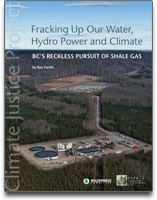 A study by the Canadian Centre for Policy Alternatives (CCPA) and the Wilderness Committee concludes British Columbia (BC) needs to pull back a ballooning shale gas industry.
A study by the Canadian Centre for Policy Alternatives (CCPA) and the Wilderness Committee concludes British Columbia (BC) needs to pull back a ballooning shale gas industry."What we're dealing with in northeast B.C. today is the natural gas equivalent of the tar sands. If the industry expands the way people believe it will, we're going to see a doubling in greenhouse gas emissions," said report author Ben Parfitt. According to the report BC is: giving access to public water supplies for 20 years to shale gas companies whose practices risk groundwater contamination; holding little to no public consultation, including inadequate consultation with First Nations; heavily subsidizing shale gas companies; depressing electricity prices; and undercutting BC's publicly owned hydroelectric utility. Expanded fracking activities could double BC's greenhouse gas emissions. The shale gas will be piped to Alberta to fuel oil sands operations, with further increased greenhouse gas emissions. Fracking - or hydraulic fracturing - injects pressurized water and chemicals into shale rock formations, forcing the gas out through cracks or fissures in the rock. Advances in horizontal drilling and higher oil prices have resulted in expanded fracking activities worldwide. Fracking uses vast quantities of water and hazardous chemicals to force release of natural gas. Hydraulic fracturing is a contentious environmental and health issue with France and New Jersey passing legislation to ban the practice in June 2011, and moratoriums in place in New South Wales (Australia), Karoo basin (South Africa), and Quebec (Canada). View November 9, 2011 Canadian Centre for Policy Alternatives reportView November 9, 2011 CBC News article View October 20, 2011 Huffington Post article View Council of Canadians, Fracking page Source:
Canadian Centre for Policy Alternatives
|
|
 Print version Print version |
Top |
| Durban Negotiations Go Overtime, Treaty Still Unlikely | 9 December 11 |
 After two weeks of negotiations in Durban, South Africa, at the 17th Conference of Parties (COP 17) under the United Nations framework convention on climate change
(UNFCCC) talks went into the night for text to be presented on Saturday, December 10, 2011. The Kyoto Protocol first reporting period ends in 2012, with civil society and southern/undeveloped countries seeking to extend the Protocol or/and replace it with a new binding and fair agreement.
After two weeks of negotiations in Durban, South Africa, at the 17th Conference of Parties (COP 17) under the United Nations framework convention on climate change
(UNFCCC) talks went into the night for text to be presented on Saturday, December 10, 2011. The Kyoto Protocol first reporting period ends in 2012, with civil society and southern/undeveloped countries seeking to extend the Protocol or/and replace it with a new binding and fair agreement.It is widely reported that Canada will pull out of the Kyoto treaty before the end of 2012, and South Africa's high commissioner to Canada has accused Canada of "bullying" developing nations to pull out of the Kyoto Protocol. "Kyoto, for Canada, is in the past," Canadian Environment Minister Peter Kent told COP 17, as six members of the Canadian Youth Delegation stood as Kent began his speech and turned their backs, revealing the message "Turn Your back on Canada" on their T-shirts. "What is frustrating me and my delegation here ...is to see for the third time that this UN conference is hijacked by a Ping-Pong game between the United States and China," said Jo Leinen, chairman of the European Parliament's environment committee. Youth delegations have been active and visible throughout the two weeks in Durban. View Manitoba Wildlands COP 17 pageView December 7, 2011 Reuters article View December 7, 2011 CBC News article View December 7, 2011 Postmedia News article View December 7, 2011 Globe and Mail article View December 7, 2011 India Economic Times article View December 7, 2011 Canada's national statement at COP17, Durban, South Africa View December 3, 2011 Montreal Gazette article Source:
Reuters, CBC, Postmedia
|
|
 Print version Print version |
Top |
| Chomiak Says Kyoto Dead in Manitoba | 9 December 11 |
 Manitoba announced it will not fulfil the Climate Change and Emissions Reduction Act, which requires the province to reduce greenhouses gases below its own Kyoto compliant target of 6% below 1990 levels.
Manitoba announced it will not fulfil the Climate Change and Emissions Reduction Act, which requires the province to reduce greenhouses gases below its own Kyoto compliant target of 6% below 1990 levels.When asked what consequences stem from the Government breaking its own law, Conservation Minister Dave Chomiak said, "well first off it's a target, and we've achieved our goals, all that I am saying today is that it looks as though all things considered, where we are right now, we are not going to be able to achieve our 2012 goals. What we will do is re-dedicate ourselves with some new actions and new measures in the new year and proceed from there." The announcement came as negotiators in Durban, South Africa struggle to achieve a binding international agreement that commits countries to reduce emissions following expiration of the Kyoto Protocol's first commitment period in 2012. "I'm embarrassed," said Gaile Whelan Enns, Manitoba Wildlands director. "I thought I was from a province that was serious about reducing emissions." Manitoba's auditor general reported that Manitoba would not reach its Kyoto targets in her 2010 report. Manitoba received international acclamation when it enacted the Climate Change and Emissions Reduction Act in 2008, but the law provided no penalties for non-compliance. The law has still not been fully enacted. The Manitoba government passed an Order In Council August 17, 2011, so sections 7, 8, 11, 12 would come into force October 1, 2012, less than three months before Act's 2012 target of 6% below 1990 emissions levels. Listen December 6, 2011 CBC coverageView December 6, 2011 CBC article View December 6, 2011 Winnipeg Free Press coverage View Manitoba Climate Change and Emissions Reduction Act View August 17, 2011 Manitoba Order In Council (314/2011) (PDF) View Manitoba Wildlands Manitoba Climate Initiatives page Source:
CBC, Government of Manitoba
|
|
 Print version Print version |
Top |
| Delta Marsh Research Station Closed Permanently | 9 December 11 |
 The Delta Marsh field station, operated by the University of Manitoba faculty of science since 1966, is shut down for good. Delta Marsh was recognized as an internationally important wetland under the UN Ramsar Convention in 1982, a Manitoba Heritage Marsh in 1988, and an Important Bird Area (IBA) in 1991.
The Delta Marsh field station, operated by the University of Manitoba faculty of science since 1966, is shut down for good. Delta Marsh was recognized as an internationally important wetland under the UN Ramsar Convention in 1982, a Manitoba Heritage Marsh in 1988, and an Important Bird Area (IBA) in 1991.The research facility on Lake Manitoba was hit by catastrophic flooding in spring 2011 and damage was extensive. The Portage Diversion, which moves excess waters between the Assiniboine River and Lake Manitoba, is situated along one side of Delta Marsh and the research station. In 2011 spring floods the diversion was widened and extended in order to move significantly more waters to Lake Manitoba. "We have been told the station is not viable going forward, because that particular part of the lake is and will continue to be subject to fairly dramatic weather events, and the damage that goes along with them," said university spokeswoman Leah Janzen. The university is now looking for ways to continue at least 10 research projects connected to the field station and adjacent Delta Marsh. Located on the south shore of Lake Manitoba, the facility bordered Delta Marsh, a game-bird refuge and wildlife area, about 24 kilometres north of Portage la Prairie. Recently the Manitoba government enlarged the wildlife management area (wma) where the research station and marsh are located, and protected most of the wma from development. It is not clear what compensation the research station received after 2011 spring floods, given much of the impact an damage were likely connected to emergency engineering of the Portage Diversion. View November 30, 2011 Portage Daily Graphic articleView November 28, 2011 Portage Online article View November 25, 2011 CBC News article View University of Manitoba "Delta Marsh Field Station" page View Manitoba Government Delta Marsh Wildlife Management Area Expansion web page Source:
CBC, Portage Daily Graphic
|
|
 Print version Print version |
Top |
| Bipole III Licensing Hearings Announced | 7 December 11 |
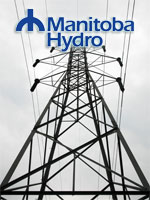 Manitoba announced Clean Environment Commission (CEC) hearings will be held on the proposed Bipole III transmission line project December 2, 2011. The hearings will be scheduled after a 90 day public review of Manitoba Hydro’s environmental impact statement (EIS) for the Bipole III project.
Manitoba announced Clean Environment Commission (CEC) hearings will be held on the proposed Bipole III transmission line project December 2, 2011. The hearings will be scheduled after a 90 day public review of Manitoba Hydro’s environmental impact statement (EIS) for the Bipole III project.The EIS review period has not started and is expected in early 2012. Internal review of the EIS, public notifications of the review, and placement of the Bi Pole III materials in public registries all occur before the review period begins. The project is the largest, most expensive transmission project in the history of Manitoba. The original study area covered over 20% of the province. "It’s possible there could be some hearings next summer, but you can’t have too many hearings during the summertime because nobody is going to show up. Perhaps some in the early summertime and the rest in the early fall," said CEC chairperson Terry Sargent. Conservation Minister Dave Chomiak announced participant assistance funding will be made available to participants in the public hearings, and there will be a comprehensive Crown-Aboriginal consultation process for Bipole III. No details regarding the CEC process or the amount of money available have been announced. The 1400 kilometre line is needed for reliability and security when sending hydroelectric power from northern to southern Manitoba, and to move more power to export markets in the United States. The terms of reference from the Minister to the CEC Chair for these hearings are not yet available. View December 3, 2011 Winnipeg Free Press articleView December 2, 2011 Government of Manitoba press release View December 2, 2011 CJOB article View Manitoba Hydro, "Bipole III" page View Manitoba Wildlands Bipole III page View Government of Manitoba: Environmental Assessment and Licensing Branch homepage Source:
Government of Manitoba, Winnipeg Free Press
|
|
 Print version Print version |
Top |


 RSS Feeds:
RSS Feeds: